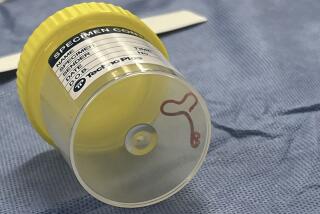Worm Research Detects a Clue to Nerve Maladies : Medicine: The discovery of some defective genes might unlock the mysteries of Alzheimer’s, Huntington’s and Lou Gehrig’s diseases.
- Share via
Researchers working with worms have identified certain defective genes that cause functioning nerve cells to die--a finding they hope may offer insight into conditions such as Alzheimer’s, Huntington’s and Lou Gehrig’s diseases.
Those diseases, called neurodegenerative diseases, occur when functioning nerve cells die. They affect millions of Americans, but it remains a mystery why particular neurons die and what molecular changes cause them to do so.
“This is a model for how mutations can cause nerve cells to die,” said Martin Chalfie, an author of the paper published today in the journal Nature. “There is the hope and the possibility that there would be human counterparts to the genes that we’re looking at.”
Chalfie’s findings could point to new ways of approaching the development of diagnostic tests for neurodegenerative diseases. They might also provide a way of screening possible drugs that might slow the process of neurodegeneration.
But Chalfie emphasized that it remains unknown whether his findings apply to humans.
“No one has any idea that this has anything to do with those human diseases. . . . But from the work that we have done, we have a way of studying cell death, or neuron degeneration, that is virtually unique,” he said.
The research findings arose from studies of a microscopic roundworm called Caenorhabditis elegans. The worm, which eats bacteria in soil, is a useful tool for research into the nervous system and cell changes because its tiny size and brief life make it a microcosm for nervous systems of larger animals.
Over the last two decades, researchers have identified and counted every cell in the animal’s body, including 302 nerve cells. And they have been able to observe cell changes over the animal’s entire three-day development from an egg to a mature adult.
Chalfie and a colleague, Eve Wolinsky, had been studying six particular nerve cells in the worm that control its sense of touch--a sense that can be tested by tickling the worm with an eyebrow hair glued to a toothpick and seeing if the animal moves away.
The researchers, who are from Columbia University, found animals that were insensitive to touch and identified particular genes needed for the development of healthy “touch cells.” And they found that certain genetic mutations, or defects, could make those particular nerve cells degenerate and die.
“By doing these studies . . . we can look at individual cells, documenting in detail the events that occur during cell death,” Chalfie said. “We can also manipulate the animal genetically . . . and study how the mutant genes cause cell death.”
In addition, Chalfie said the mutant worms can be used for screening drugs that might slow or stop neurodegeneration. Genetic material from the mutant worms can be used to see if similar genes exist in humans.
Alzheimer’s disease affects more than 4 million Americans over age 65 and is characterized by progressive disorientation and loss of memory. Lou Gehrig’s disease, or amyotrophic lateral sclerosis, attacks nerve cells in the brain and spinal cord affecting muscle movement.
Huntington’s disease is an inherited, degenerative brain disorder that results in violent, involuntary movements. It affects about 25,000 Americans. Lou Gehrig’s disease affects about 30,000.






